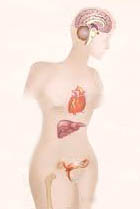Estrogens female hormones

A collective term for the “female” sex hormones, including prohormones (chemical precursors the body converts to hormones) and metabolites (byproducts of HORMONE METABOLISM). Estrogens are among the steroid hormones the body synthesizes from cholesterol. Estrogens derive from ANDROGENS (the “male” sex hormones).
Common use applies the singular term estrogen to refer to any or all of the three endogenous (naturally occurring within the body) estrogen hormones: estradiol, estriol, and estrone. Estradiol is the most potent and most biochemically active of the estrogens. Estrone is very similar in chemical structure to estradiol though exerts a weaker response. Estriol is a metabolite of both estradiol and estrone.
Estrogen levels
In a woman’s body the levels of these closely related hormones change at MENARCHE and at MENOPAUSE, and fluctuate within the menstrual cycle and with PREGNANCY. Estradiol is the predominant estrogen during the years of FERTILITY, with the less-potent estrone moving into dominance after menopause. In a man’s body estrogen levels remain fairly constant. The HYPOTHALAMUS’s secretion of GONADOTROPIN-RELEASING HORMONE (GNRH) regulates the hormonal cascade for production and release of the estrogens. In women this cascade is cyclic, establishing the monthly menstrual cycle during the four decades or so a woman is fertile.
Men and women alike have estrogens (just as both sexes also have androgens). The OVARIES in women, the TESTES in men, and the adrenal cortex of the ADRENAL GLANDS in men and women synthesize (produce) most of the estrogens in the BLOOD circulation. During pregnancy the PLACENTA produces estrogens as well. Adipose (fat) cells and the LIVER in both sexes, and the breasts in women, also synthesize small amounts of estrogens.
In women the estrogens establish secondary sex characteristics and fertility, and maintain pregnancy. The estrogens are essential in both sexes for cholesterol metabolism, BONE calcium content and density, thyroid function, SKIN health, and collagen maintenance. The estrogens also have roles in mood and emotion, probably in both men and women though more pronounced in women because estrogen levels fluctuate with the menstrual cycle.
Various endocrine disorders may result in estrogen levels that are too high or too low, with consequences for fertility in women and for cholesterol metabolism in men and women. Doctors use pharmaceutical preparations of estrogens and estrogen analogs (drugs that bind with estrogen receptors though do not have estrogen activity) for a diverse array of therapeutic applications including CONTRACEPTION (birth control pills), treatment for HORMONE-DRIVEN CANCERS (notably PROSTATE 126 The Endocrine System CANCER) in men, OSTEOPOROSIS and BREAST CANCER prevention in women (estrogen analogs), and fertility treatments in women.
Products with estrogens and progesterone
Estrogen products were a mainstay of therapy (alone or in combination with PROGESTERONE) to relieve the discomforts of menopause for much of the latter half of the 20th century. Research in the early 2000s demonstrated significant risks with routine hormone replacement therapy (HRT), however, resulting in a change in medical practice to use such products within narrow therapeutic guidelines and for the shortest amount of time possible to achieve a therapeutic result.
For further discussion of estrogen within the context of the endocrine system’s structure and function please see the overview section “The Endocrine System.”
See also CHLOASMA; ENDOMETRIAL CANCER; FOLLICLE-STIMULATING HORMONE (FSH); GYNECOMASTIA; HORMONE THERAPY; HYPOGONADISM; HYPOTHYROIDISM; INFERTILITY; LUTEINIZING HORMONE (LH); MENSTRUATION; PHYTOESTROGENS; POLYCYSTIC OVARY SYNDROME (PCOS); TESTOSTERONE; THYROID GLAND.
Open discussion on the topic Estrogens female hormones
Similar interests
- Nuovi Casino
- Casinos Not On Gamstop
- UK Casinos Not On Gamstop
- Casinos Not On Gamstop
- UK Casinos Not On Gamstop
- Casino Non Aams Italia
- Slot Sites Not On Gamstop
- Meilleur Casino En Ligne
- Non Gamstop Casino Sites UK
- Meilleur Casino En Ligne
- Casino En Ligne France
- Best Non Gamstop Casinos
- Casinos Not On Gamstop
- UK Casino Not On Gamstop
- Casinos Not Signed Up To Gamstop
- Best Slot Sites UK
- Non Gamstop Casino Sites UK
- Online Casinos Nederland
- Online Casinos Nederland
- Casinos Not On Gamstop
- Best New Uk Casinos Not On Gamstop